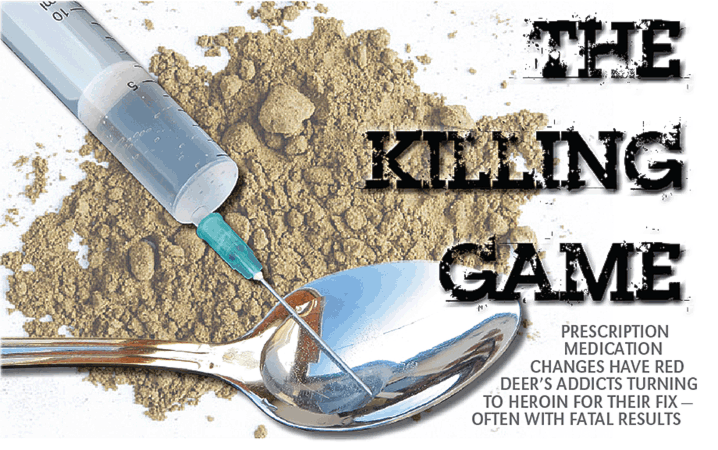What was old is new again — and it’s killing people.
Heroin is getting cheaper and stronger, there’s more around and users are making mistakes with their doses.
“It’s out of control,” says Carl, a 20-year junkie who moved to Red Deer in an attempt to get clean after Calgary police broke up his gang.
So far, the 45-year-old father of seven is having limited success.
Carl offered a glimpse into his world on a Monday afternoon, just hours after his most recent hit, while warming up and visiting friends at Berachah Place — a day shelter where people can drop in for coffee, a bite to eat and companionship.
Born in England, Carl immigrated to Montreal with his family when he was in Grade 1. He doesn’t remember how he became addicted to heroin, only that he suffered from depression and turned to drugs to help mask his pain.
He is among those watching helplessly as an agonizing trend takes hold. Only three days had passed since the most recent incident of a fatal overdose among the group of regulars at Berachah Place.
Changes in prescription medication have played a role in the rising use of heroin on the street, says Cpl. Len Larson, head of the Red Deer City RCMP’s street team.
“They’ve changed the (formulation) so you have a hard time injecting them, and they’re slow release so you’re not getting your high like you used to,” says Larson.
For a number of years, prescriptions drugs including oxycodone — manufactured and sold as OxyContin — were commonly traded on the street by addicts looking for a particular brand of high.
In February 2012, Health Canada attempted to limit street use of OxyContin by replacing it with OxyNEO. The replacement drug is more difficult to inject because it is harder to crush and the binding agent gels when mixed with water, says Sylvan Lake pharmacist Giovanni Ursella.
A generic drug manufacturer is now distributing the drug previously marketed as OxyContin, says Ursella.
In the meantime, however, the use of heroin has become far more common than in was in the past.
It’s not just that junkies need a replacement for “oxy,” says Carl. There’s more heroin around than there was before, it’s cheaper as a result and the concoctions are unknown, leaving users unclear on how much they need to get the high they expect.
The toll on users has reached frightening proportions.
Berachah Place co-ordinator Millard MacDonald says drug overdoses are taking at least one client a month from among the 120 to 140 people he sees every day, including one death in late February while staff and volunteers were still trying to shake the loss in January of a vivacious young mother of two who had found a place in everyone’s heart.
A copy of her portrait is posted on the office wall at Berachah Place, a grim reminder of the deep sorrow hidden behind the warm smiles and the hot coffee.
Posters showing the names and faces of others were taken off the wall late in February.
MacDonald explains that the collection is being reorganized into a monument.
MacDonald and his crew were recently approached by the founders of SMILE — Supporting Many Individuals while Lending Encouragement — to see if they would like to have a feature wall honouring those who have become sober and in memorial of those who have died.
Creator Terri Grills says she and her partners put forward the proposal of building an apple tree, with leaves and apples on the branches for those who are struggling to stay clean, and fallen leaves for those whose lives were sacrificed to their addiction.
It will be a big project, said Grills. Berachah Place has provided her with a list of 50 people who died from overdosing on street drugs.
Carl says he had three close calls in the last year, giving Berachah Place and the people of Red Deer full credit for the help he has received since moving here.
He speaks softly, almost a whisper, his voice drifting off at times.
“Red Deer is a nice town. It saved my life. They gave me a place, opened my eyes. People care. This is a great place to raise your kid, raise a family. There are a lot of opportunities here.”
bkossowan@www.reddeeradvocate.com
On Friday: In the 22 years since she first tried cocaine, Gail, 46, has found various ways and means of feeding her habit, including dealing drugs and selling her body.
